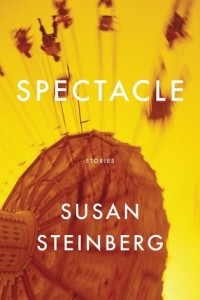Interview by Lori M. Myers
I like to tell writers in my workshops that they should first learn the rules and then break them. Those words tend to be freeing because we all remember those public school days when breaking any sort of rule had you spending time in a classroom corner.
Author, artist, and University of San Francisco professor Susan Steinberg considers that corner her metaphorical home. She sometimes tosses away standard characters, plots and pat endings and instead plays with language and ambiguity. It is an “experiment” which has served Steinberg well.

Susan Steinberg
Lori: How do you define experimental literature? What should the reader feel, do you think, after reading your work?
Susan: I’ve been defining experimental writing both in terms of process and the finished piece, but I believe it starts with the writer’s approach to the work. Is the writer trying something new? Applying something different? Taking chances either narratively, stylistically, formally, or syntactically? And is the finished piece, as a result of any experimentation, unconventional? Does it resist categorization?
And I’m never pushing for the reader to feel any one specific emotion. I just want the reader to feel something.
What writers do you emulate as far as style, technique, and risk-taking?
That’s a difficult question, because my work grows out of the visual arts. If I can answer it that way, I’m inspired by a lot of visual artists, like Cindy Sherman and Hannah Hoch and Pipilotti Rist, to name a few.
Do you encourage your writing students to learn the rules and then break them?
I’m less invested in showing students how to write according to the “rules” of fiction writing (as in following a conventional structure of rising action, climax, and the rest), and I therefore often show them a range of writing styles right from the beginning of the semester. But I am very invested in making sure they understand the rules of grammar and punctuation. And once they know all of it, I suggest that breaking the rules is always an option, though it doesn’t always work.
Any current projects you’re working on right now?
I’m working on a new collection of linked short stories that, at this point, focus on female narrators’ responses to works of visual art by men.
I encourage memoirists to borrow techniques and devices from all areas in writing: poetry, fiction, and experimental or hybrid work. — Steinberg
Are there any hobbies/interests/travel that sort of mirror the risks you take in your writing? In what ways do your paintings achieve this?
In terms of content, I’ll go with spelunking (now called “caving,” I’m told. ) Moving slowly, perhaps recklessly, into a dark, cold, untraveled space. I should say this is not a hobby of mine.
In terms of form/style, it’s like learning any new thing, only without instruction.
My writing process is very similar to my painting process. There’s a lot of trial and error in each. That said, I feel I’m taking more risks in my writing, because, unlike in the visual arts, it seems that the smallest turn away from convention can startle a reader. I mean, I start a few stories with a semi-colon, and it’s considered risky.
Hippocampus Magazine is a publication featuring memoir writing. How can memoirists use experimental writing to enhance their work?
I encourage memoirists to borrow techniques and devices from all areas in writing: poetry, fiction, and experimental or hybrid work. Why not try on a new form, if it fits the content of the memoir? Not every story can be told in chapters. Not every scene can be told in complete sentences.
[boxer set=”Lori-Myers”]


